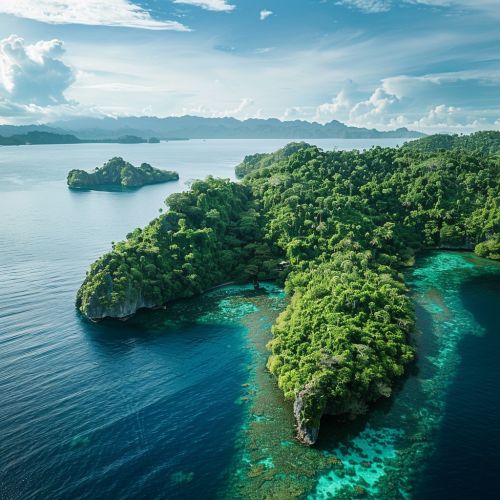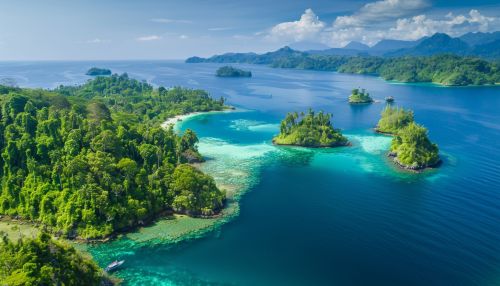Indonesian Islands
Geography and Overview
The Indonesian archipelago is a vast collection of islands located in Southeast Asia, straddling the equator and extending between the Indian and Pacific Oceans. Indonesia is the world's largest island country, consisting of more than 17,000 islands, of which approximately 6,000 are inhabited. The major islands include Sumatra, Java, Borneo, Sulawesi, and New Guinea. These islands are characterized by diverse topographies, ranging from coastal lowlands to mountainous interiors.


Major Islands
Sumatra
Sumatra is the largest island entirely within Indonesia and the sixth-largest island in the world. It is known for its rugged terrain, tropical climate, and rich biodiversity. The island is home to several national parks, including Gunung Leuser National Park, which is part of the UNESCO World Heritage-listed Tropical Rainforest Heritage of Sumatra. Sumatra's economy is largely driven by agriculture, with palm oil, rubber, and coffee being significant exports.
Java
Java is the world's most populous island and the political and economic heart of Indonesia. The island is home to the capital city, Jakarta, and other major cities such as Surabaya and Bandung. Java's landscape is dominated by a series of volcanic mountains, including the active volcano Mount Merapi. The island's fertile volcanic soil supports extensive agriculture, particularly rice cultivation.
Borneo
Borneo, known as Kalimantan in Indonesia, is the third-largest island in the world and is shared by three countries: Indonesia, Malaysia, and Brunei. The Indonesian portion of Borneo is known for its dense rainforests, which are among the oldest in the world. These forests are home to unique wildlife, including the endangered Bornean orangutan. Borneo's economy is heavily reliant on natural resources, including timber, coal, and palm oil.
Sulawesi
Sulawesi, formerly known as Celebes, is characterized by its distinctive shape, with four peninsulas radiating from a central core. The island's complex geography includes rugged mountains, deep valleys, and extensive coastline. Sulawesi is renowned for its marine biodiversity, particularly in the Coral Triangle, and is a popular destination for diving and snorkeling. The island's economy is diverse, with agriculture, mining, and tourism playing significant roles.
New Guinea
New Guinea is the second-largest island in the world, divided between Indonesia and Papua New Guinea. The Indonesian portion, known as Western New Guinea, comprises the provinces of Papua and West Papua. This region is noted for its cultural and biological diversity, with numerous indigenous tribes and a wide variety of ecosystems, from coastal mangroves to alpine meadows. The economy of Western New Guinea is primarily based on mining, with significant deposits of gold and copper.
Lesser Sunda Islands
The Lesser Sunda Islands are a group of islands located to the east of Java and Bali. This archipelago includes well-known islands such as Lombok, Sumbawa, Flores, and Timor. The Lesser Sunda Islands are characterized by their volcanic origins, with several active volcanoes, including Mount Rinjani on Lombok. The region is also known for its unique cultural heritage and traditional crafts.
Maluku Islands
The Maluku Islands, also known as the Moluccas, are located in eastern Indonesia. Historically referred to as the "Spice Islands," they were once the world's primary source of spices such as nutmeg, mace, and cloves. The Maluku Islands are composed of numerous small islands, with Ambon and Ternate being among the most significant. The region's economy is still influenced by spice cultivation, along with fishing and tourism.
Ecological Significance
Indonesia's islands are part of the Indomalayan realm and are known for their high levels of biodiversity and endemism. The archipelago's varied ecosystems include rainforests, mangroves, coral reefs, and savannas. Indonesia is home to several critically endangered species, such as the Sumatran tiger, Javan rhinoceros, and Komodo dragon. Conservation efforts are ongoing to protect these species and their habitats, although challenges such as deforestation and habitat loss persist.
Cultural Diversity
Indonesia's islands are home to a rich tapestry of cultures, languages, and traditions. The country recognizes over 300 ethnic groups and more than 700 languages. Each island and region has its own unique cultural identity, influenced by a mix of indigenous traditions and external influences from trade, colonization, and migration. Notable cultural practices include the Toraja funerary rites in Sulawesi, the Balinese Hindu ceremonies, and the Batak traditions in Sumatra.
Economic Activities
The economy of Indonesia's islands is diverse and multifaceted. Agriculture remains a cornerstone, with key crops including rice, palm oil, rubber, and coffee. The archipelago's extensive coastline supports a robust fishing industry, while the rich natural resources of islands like Borneo and New Guinea contribute to significant mining activities. Tourism is also a vital economic sector, with destinations such as Bali, Lombok, and Raja Ampat attracting millions of visitors annually.
Challenges and Conservation
Indonesia's islands face several environmental and socio-economic challenges. Deforestation, driven by logging, agricultural expansion, and mining, poses a significant threat to biodiversity. Marine ecosystems are also under pressure from overfishing, coral bleaching, and pollution. Additionally, the country grapples with issues related to poverty, infrastructure development, and natural disasters such as earthquakes and tsunamis. Conservation initiatives, both governmental and non-governmental, are crucial in addressing these challenges and promoting sustainable development.
